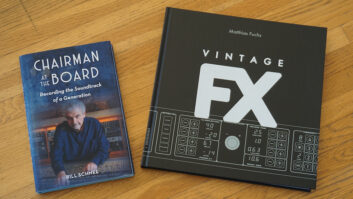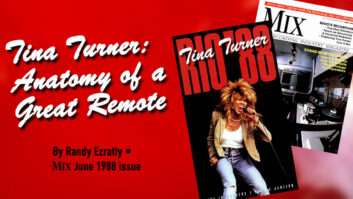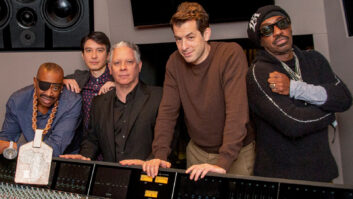In January 1996, this magazine reported that 3M was getting out of the recording tape business. Ampex was changing its name to Quantegy. Alesis was advertising the new, beefed-up ADAT XT, and Avid was touting its AudioVision system for (gasp!) combining audio and video on a single computer. The news page announced half-a-dozen manufacturers now had sites on the World Wide Web. And on page 28, the “Insider Audio” column appeared with a new byline — mine.
Actually, my first essay for Mix was published the previous September — sort of a “dry run” so that the editors and I could get a feel for each other. It was entitled “Fear of Frying (My Studio)” and was about the dread I felt every time I changed anything in my setup. I guess they liked what they saw. Unfortunately, that dread has never gone away.
The 10 years since have been, as the Chinese curse says, interesting times, during which I’ve somehow managed to produce 120 columns. I’ve written columns I’m very proud of and columns I’d very much like to take back. There were columns that flowed out of my keyboard from the original idea to the last period and columns that were like pulling teeth to write (although hopefully not to read). And there were a few that were so inflammatory that the editors wouldn’t run them. I’ve gotten tons of feedback, most of it favorable, but a good portion of it falling into the “You don’t know what the hell you’re talking about” category, and it often happened that the writers of the latter were right.
So in honor of this anniversary, I’ve brushed the cobwebs off of some of my old columns and dug out a few of the things I’ve said in my 10 years on the “Insider Audio” beat that still make me smile — or make me cringe. Here are a few that made me smile.
On the future of hardware (January 2002):
As long as we have hands, fingers and feet, we will need to be able to hold, push, turn, press, squeeze and stomp on our tools if they are going to feel like they’re ours. Until, of course, purely synaptic-driven interfaces (with appropriate neural feedback) are perfected. At that point, all bets are off.
On using systems that are too perfect (July 1997):
Finding defects in a tool and turning them into virtues is an age-old practice, and much of the music of the early rock era is defined by this. And perhaps that is what people are really missing in today’s gear: the serendipity of finding something weird and figuring out how to exploit it artistically.
On dealing with clients (October 1996):
Audio is a very high-tech field, and it’s also a high-glamour field. A lot of clients like the latter part, without understanding very much about the former. But they think they do, and that makes them dangerous.
…and more (December 1998):
Whether or not they have anything to do with their projects, some clients will insist that you have the latest plug-ins, operating systems, digital effects and tube preamps or they’ll take their business somewhere “hipper.” It doesn’t make any difference that they’re producing a video that’s going to end up on a kiosk in the middle of a railroad station waiting room — if you haven’t got 24-bit 96kHz converters and a mixer with automated effects and 5.1 surround panning, they’re not interested in you.
On the problems of keeping up with technology (September 1995):
Imagine how guitar players would react if every time Fender came out with a new model, it had a different number of strings in a different order and the frets were arranged in a new way.
…and more, from producer/engineer Tom Bates (April 2000):
“I hate going up and down the aisles at AES and seeing 800 new little black boxes. I don’t quite grasp what they do, and I’m not sure I need to do any of those things. It’s all got to be work-driven. There’s no point answering a question nobody has asked or solving a problem nobody has.”
On life lessons (August 1999):
If you ever — well, more than once — ask yourself, “What am I doing here?” then you probably don’t belong here. If you don’t love this, if you can’t imagine yourself spending the rest of your life anywhere else except in front of or surrounded by a bunch of speakers, devoting all your energy and creativity to perfecting in one way or another the sounds you hear, then you’re in the wrong place.
On user manuals, from Digidesign support tech Beto Carvalho (February 2000):
“Some people call support every time they try to do something they haven’t done before, without ever consulting the manual. And they say, ‘Walk me through this.’ When we tell them to read the manual, they’ll say, ‘I don’t have time for that!’ or ‘I don’t understand it.’ We understand that manuals are not exactly light reading, but it’s not support’s job to read it for you. As a colleague of mine once said, ‘That’s why we call it Pro Tools and not Amateur Tools.’”
THE DUMB STUFF I HAVE SAID
This little gem from November 1996: DVD seems to be designed from the git-go to be all things to all people, and history says that may not be such a great idea.
As it turned out, of course, DVD was a great idea, and it is all things to all people — almost. It’s not the medium’s fault that it’s still not particularly well-established as a music-only delivery medium.
I admit I have had a very hard time accepting the Internet as a serious delivery system. As a veteran of 300-baud modems, I didn’t believe that high-speed Web access would ever make it into a significant number of homes, and I thought that music lovers used to the sound of CDs would never settle for compressed audio.
So I wrote this pessimistic piece in February 1997: Even with an ISDN or T1 line, handling more than one channel of high-quality audio at a time is next to impossible. The fact that the best we can hope for in terms of soundtracks in this brave new world of the Internet is the ability to access a few megabytes of samples accompanying a telephone-quality voice track is sobering, to say the least. For an industry that has strived for so many years to attain the highest reproduction quality, it’s pretty odd to be staring down the barrel of sonic mediocrity and calling it the future.
Although I still like that last sentence, the real lesson, which I keep forgetting, is never assume that the public will value quality over convenience. And also never underestimate the ability of truly dedicated engineers to force camels through eyes of needles. I expounded more nonsense in July 2001: There will always be, as there always has been, a race between the Net’s capacity to carry traffic and the amount of traffic it’s being called upon to carry. Every year, some expert solemnly intones, “In two years, we will have three times as much bandwidth as the nation will require,” but, inevitably, the demand manages to catch up with, and usually exceed, the supply. As it is now, DSL and cable Internet are penetrating the domestic market very slowly — only about 5 percent of residential customers have high-speed hookups, two-thirds of them through cable and the rest through DSL. But that is all we’re going to have for a while.
Yeah, right. Then there was this odd statement (October 1998): A lot of current platforms have trouble accessing a modem and a MIDI cable at the same time, to say nothing of dealing with audio. I don’t know if you’ve ever tried to pull down a large file from the Web at the same time you’re recording a new track on your hard disk, but the experience isn’t pretty. Even with a cable modem or T1 line, the World Wide Wait is not a pleasant way to get information quickly.
Now, why would anyone want to download a file while recording another one? But I guess I never asked myself that. And when it comes to pleasant times on the World Wide Web, I certainly never foresaw how many people would fall in love with MP3s and Internet porn. It’s thinking like this that blew my chances to make millions — or lose them — in the dot-com boom.
I did a column about Napster that sparked a gigantic, heated online discussion that included this paragraph (October 2000): People who like music will continue to pay for it, if the music is what they want and the price is reasonable. Folk singers, rappers, garage bands, jazz players, world musicians, techno heads and anyone else who wants to make a living in this business without turning their music into zillion-selling pabulum can’t possibly be harmed by technologies that make it easier to get more music to more people, and we as professionals, helping them make their dreams into reality, will always be needed.
People, as it turns out, would rather get something for free than have to pay for it — unless it’s ridiculously convenient and the hot playback device of the day will only play files you’ve paid for. (Thanks, Apple.) Furthermore, lots and lots of musicians are convinced they can realize their dreams without any help from us engineers or producers, thank you very much. We’re still needed, but many of the folks who need us don’t know that anymore.
Okay, enough self-flagellation. Writing “Insider Audio” has given me a wonderful opportunity to have fun with our industry. Some of the columns I’m proudest of are the parodies, especially descriptions of ridiculous new products, many of which were inspired by friends or readers saying to me, in what they might have thought was a private conversation, “Wouldn’t it be cool if they could make…” Like this piece of imaginary retro gear, suggested by David Moulton (November 1996):
American Foods Gelaplex Reverberator (1954): The Gelaplex was an attempt by the marketing department of the company’s Gelatin Dessert division to go head-to-head with Jell-O® without resorting to the risky (as they saw it) medium of television advertising. Although it was a colossal failure, the Gelaplex presaged the acoustical modeling that became a crucial design element in the digital reverbs of the future. The device is stunning in its simplicity. The 1/114th-scale aluminum molds of desirable acoustical spaces are provided with the system, and purchasers can then create gelatin models of these spaces using Amfoo’s YummiGel® product. Sound is input into the YummiGel using transducers mounted in soft-drink straws (supplied with the original units). Other straws contain tiny microphones for picking up the reverberated sound. The vibrations of the transducers travel through the YummiGel to its boundaries and to the pickups in a manner equivalent to sound in a reverberant space.
Then there was the column that extrapolated on the then-current trend of naming equipment after famous people who had nothing to do with audio (April 1997).
Billgates: An all-purpose device that performs every function and operation you can think of in a studio, although it does none of them particularly well. Has a tendency to crowd out gear from competing manufacturers, and in some cases actually absorbs it. Takes up more rackspace than you would believe possible. In spite of the fact that it runs far more sluggishly than similar products, and its confusing front panel contains dozens of badly labeled controls that you will never use, it has become an industry standard. The initial price seems quite reasonable until you realize it exacts a small fee from every user each time you plug it in.
Rush: A unique signal processor — very popular with users having only one ear (and a corresponding volume of brain matter) — that ignores anything even remotely near the left input. Outputs are parallel and labelled “Right!” and “Ditto!” Extremely effective distortion algorithm, such that any data that goes in emerges completely unrecognizable and way, way out of phase. Unit is much bulkier than it needs to be and output is unnecessarily loud. Inputs and outputs are XLR, but all internal circuitry is utterly unbalanced.
Windows’ security holes and Rush’s little pharmacological problems hadn’t become issues yet or you can be sure I would have gone after them with a vengeance.
HELLO GRUMPMEIER
And, of course, there’s my good buddy Grumpmeier, who was actually the invention of my real good buddy Tim Tully, former editor of Electronic Musician. He came up with the idea when he was doing a newsletter called Studio Software Report. He thought one of my contributions was a little too vicious to put my byline on, so he borrowed an old trick from The New Yorker: When they run a column that’s too hot for attribution, they preface it with “A friend writes…” So the item started off, “Our friend Grumpmeier reports…”
Here are two of my favorite Grumpisms. The first is from an “Ask Grump” advice column (April 2001): The lead singer of the P*gf*c*ers, Nolo Vox, does this really cool thing on their tune P*ss on Y*u B*t*h in which it sounds like he’s throwing up into a trash can. How did they pull off that amazing sound?
I checked with their producer, the London Conservatory — trained Trevor Trevor III. He told me, “We did most of the album at a studio in Hollywood, but for that one track, we rented a manor house in the Cotswolds for a week. We sent all the servants away except for the French cook. We tried setting the mics up in X-Y, M-S, ORTF and B-format Ambisonic. We filled about 20 reels of tape, but I wasn’t happy with anything we had. The last night we were there, after a dinner of frog’s legs, octopus, blood pudding and trifle, Nolo suddenly said he wasn’t feeling too well and ran out of the dining room. He made it as far as a large metal drum that was sitting in the hallway that had been filled with — um, uhh — sugar. As luck would have it, one of my assistants had accidentally dropped a Shure wireless mic into the drum earlier that day, and it was still on. It was a wonderful moment, one that would be hard to reproduce, I’m sure.”
The other is from an interview with Grumpmeier’s son, a number-one-with-a-bullet pop-goth-gangsta-techno-grunge star (April 2002): What I really want to do is more classical. You know, what Billy Joel did, but instead of writing like some dead guy, I’ll just sample the stuff like I did with Beethoven Bytes. That way, instead of imitating the dude, I’m actually using his actual music. You know, I studied piano, too, when I was a kid, and my mom has been bugging me to start taking lessons again. Do you think you will? I asked. Naah, I’m much too busy making records to spend any time learning anything about music.
FEEDBACK WELCOME
But the best part of doing my column has been the response from you, the readers. Most writers have to wonder whether their words are actually reaching their intended audiences, but I don’t — Mix readers send letters to the editor, e-mails to me and postings to Usenet groups, and feel no compunction about ambushing me at trade shows. Whether you love or hate what I say, you let me know what you think, and that’s all any writer can ask for. It keeps me motivated and it keeps me honest. Thank you.
This whole experience has worked so well that I was actually able just in the last few weeks to persuade a publisher, Thomson Course Technology, to put together a book of some of my columns, which will be out later this year. I’ll keep you posted.
May the next 10 years be as interesting.
Paul Lehrman has nothing more to say.







